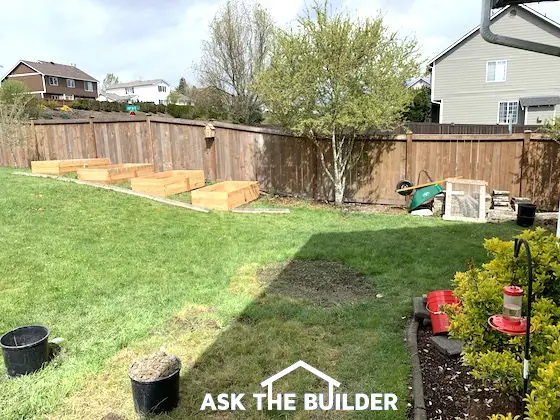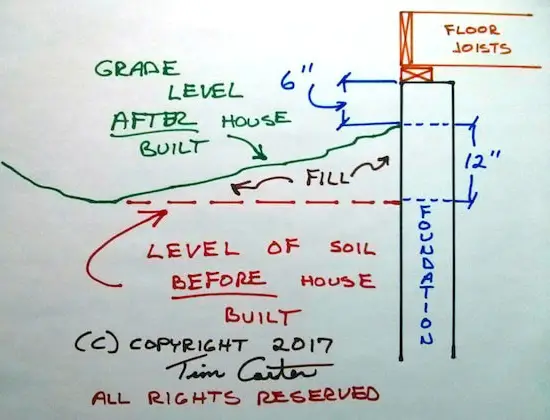Basement Leak Repair

Basement Leak Repair | Water flowing through the soil creates a swamp in the backyard of this home and many others in the neighborhood. It’s easy to dry it out. Copyright 2022 Tim Carter
Basement Leak Repair - Best is Doing it Outside
Ande lives in Puyallup, WA and reads my weekly column in her paper. She’s got a very common problem. In fact, tens of thousands of people suffer from it in places where there’s abundant rainfall for many months during the year.
Ande’s backyard turns into a miniature Okefenokee Swamp when it rains. Her crawlspace also floods. She asked for my assistance in solving her basement leaking. Fortunately, my college degree is in geology with a focus in hydrogeology - the study of groundwater.
Each spring I receive hundreds of emails from homeowners who have water leaking into a basement after heavy rain. It also leaks into crawlspaces. Most have soggy yards as well. The good news is that in almost all cases you can solve these problems with moderate effort and minimal expense if you can do most of the work yourself.
Basement Leak Repairs Causes
I do lots of phone coaching with homeowners like you and in a vast majority of the cases the builder caused most of the problems. The three biggest pain points are:
- roof water dumped onto the ground next to the house
- failure to slope all ground away from the house foundation
- grade the lot so all surface water drains to the natural lowest spot before the house was built
Let’s unpack these one at a time. You’d be surprised at the amount of water that falls onto your roof. If the footprint of your house’s roof is close to 1,600 square feet, a rainstorm that dumps 1 inch of rain will create just over 1,000 gallons of water falling off the roof! The last thing you want to do is dump all this water onto splash blocks at the base of downspouts. This water needs to be piped to municipal storm sewers or piped to the lowest part of your lot where water would have drained naturally before your home was built.
Read my past column about gutters and downspouts to see how to calculate how much water falls on your roof.
Leaking Basement Source - Bad Grading
The soil that touches up against your home must slope away from the foundation. If your home was built on a mountain peak, by default all the water would slope down and away from each side of your foundation. You can achieve the same thing by making sure the top of your foundation walls are at least 18 inches higher than any ground within 10 feet of the foundation.

The building code suggests that the slope of the ground should fall at least 6 inches in the first horizontal ten feet away from the foundation. Realize this is a minimum standard. More slope is better. Read my column about foundation height and the grade around your home.
Once you have the ground sloping away from the foundation on all sides, you do what’s necessary to slope your yard so water flows to the lowest point of your lot. This takes care of all surface water. It’s now time to deal with the water flowing through the top soil.
Water Moves Through Soil
When it rains, water flows into the top soil and occupies the space previously taken up by air. The water then is pulled by gravity down and then sideways. Many soils have a clay component and as you go deeper into the soil, the denser the clay becomes. This is why in the Midwest, South, and many other parts of the USA it’s easy to create a pond. The clay soil acts like a giant pottery bowl.
Knowing that this subsurface water is moving downslope towards your home, you simply have to intercept it before it hits your foundation. You then redirect this water around your home and send it on its way to the ocean. That’s where all water wants to end up if given the chance unless you live in the Great Basin of the USA or similar locations in the world.
I feel the best way to intercept the subsurface water is to dig a 6-inch-wide trench about 24 inches deep. In most situations this gets you into the dense clay subsoil. I like to put about 1 or 2 inches of clean rock in the bottom of the trench. This rock should be the size of large green grapes. Be sure there’s no sand in the rock or smaller pieces of rock.
Who Does Basement Leak Repair Near Me?
I can help you do your basement leak repair over the phone. It's easy and I even draw up the plan of what you have to do! Go here and let's get started with your leaking basement repair.
I then put a perforated 4-inch pipe on this gravel and then fill the trench to the top with the same grape-sized gravel. Water flowing through the soil hits this gravel, immediately drops down and finds its way into the drain pipe.
The trench might be L or U-shaped as it goes around your home looking for daylight. As the ground slopes away from your home the drain pipe will eventually pop out of the ground if you keep the bottom of the trench level or have a very slight 1/8-inch per foot of fall to the drain pipe. In wet periods you’ll see enough water flow out of the pipe to fill a five-gallon bucket in a minute or two!
Where is a DIY Video Showing Repairing Basement Leaks?
You can get access to a 90-minute step-by-step video showing you how to install one of these trench drains going here.
Column 1457